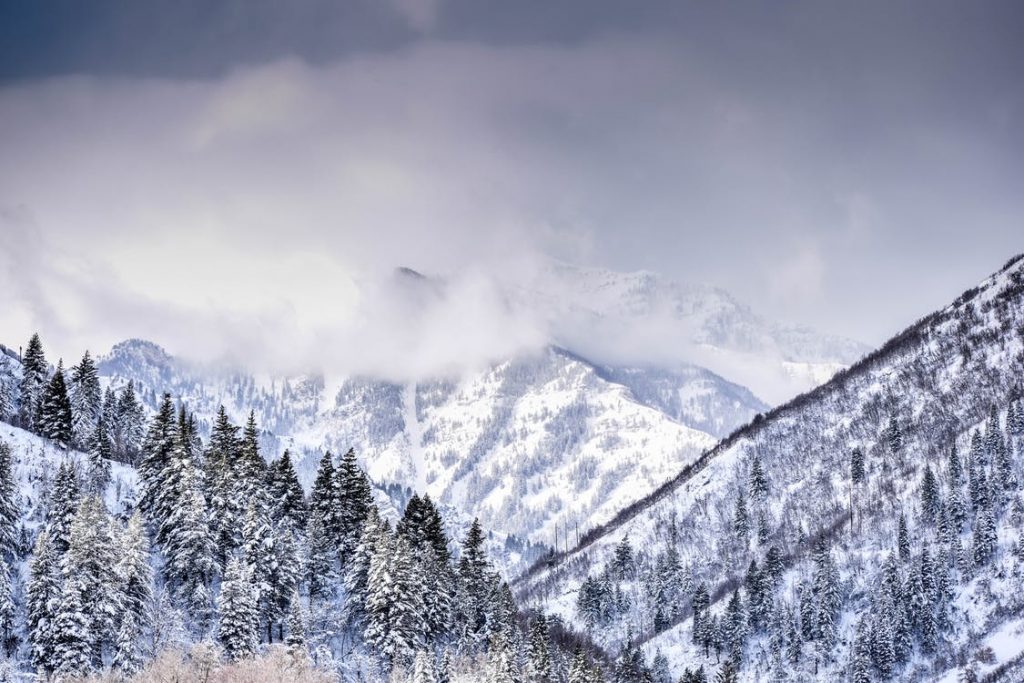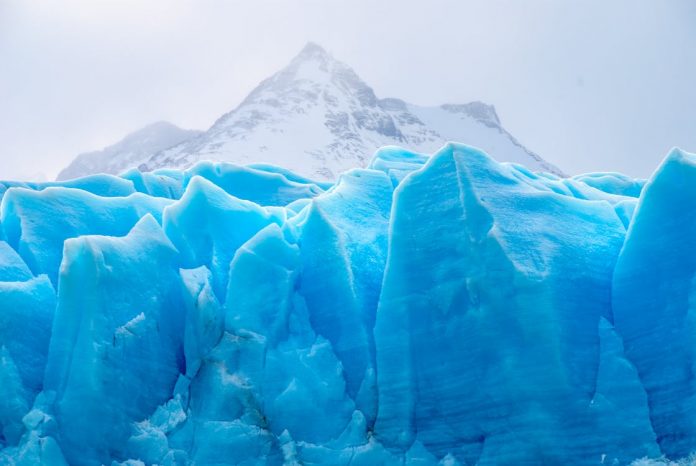Glaciers are moving sheets of ice that exist year-round. Glaciers cover approximately 10% of the Earth’s surface, eroding and shaping the underlying rock. Several specific environmental factors must be in place in order for these ice rivers to form and begin flowing.
How Glaciers Form
In Earth: Portrait of a Planet (W.W. Norton & Company, 2001), Steven Marshak lists three conditions that must be met in order for glaciers to form. First, the local climate must be cold enough to prevent full melt of accumulated winter snow. This type of climate generally exists in the polar regions and high elevations. Second, large accumulations of snow must exist in the area. Third, the slope of the rock surface must be gentle enough to keep snow from being lost by avalanche (generally less than a 30% grade) while simultaneously being protected enough that snow doesn’t blow away.
According to Marshak, glacial ice develops in a multi-step process where pre-existing ice recrystallizes in the solid state, which means that molecules in the ice rearrange to form new crystals without first melting into water:
- Older snow becomes buried by newer snow. Snow contains about 90% air due to its ice crystal structure.
- Over time, the pointed ends of individual snowflakes take on a blunted shape, causing the snow to pack together more tightly.
- The weight of the overlying snow increases pressure on the buried snow, causing a pressure solution to form. This occurs because increased pressure triggers melting of the contact points where snowflakes meet, a process called pressure melting. Pressure melting turns the snow into firn, which is a packed granular material that contains only about 25% air.
- Pressure melting continues to melt firn crystals at their contact points. This produces miniscule amounts of water, which then recrystallizes in the spaces between the firn crystals. As this process is repeated over time, the firn forms a solid mass of interlocking ice crystals that contains only about 20% air.
The entire process of turning snow into glacial ice can take anywhere from decades to millennia depending on the amount of snowfall in the region.
How Glaciers Move
Just as with regular rivers, the ultimate cause of glacier flow is gravity. Glaciers can move from 10 to 3000 meters each year, depending on the steepness of the slope and whether water is present at the glacier’s base.
Marshak describes two main types of glacier movement. In basal sliding, pressure from the weight of the glacier causes water to melt at its base. The water, or slurry if the water mixes with underlying sediments, reduces friction between the glacier and its substrate, or underlying rock, allowing it to flow.
With internal flow, the mass of ice changes shape internally over time without breaking or completely melting. One method of internal flow occurs when individual ice crystals change shape by stretching and rotating over time. An alternate method of internal flow occurs when water forms very thin films on the surface of ice crystals, allowing them to slide past each other. Marshak points out that internal flow generally takes place in the coldest polar regions where a glacier’s base in frozen to its substrate.
Conditions Must be Right to Form a Glacier and Induce Flow
Several environmental factors must be in place in order to form a glacier. The climate must produce sufficiently cold temperatures and amounts of snow. Then physics takes over, as snowflakes become glacial ice crystals through pressure melting. Pressure melting is then responsible for the presence of water either at the base of a glacier or between ice crystals, allowing the force of gravity to take over to make the ice sheet move. It is this flow that produces the remarkable landscapes of glacial regions.
Types of Glaciers
Glaciers are moving rivers of ice that exist year-round. Their progress constantly shapes the Earth’s surface and affects not only topography, but sea level as well. In Earth: Portrait of a Planet (W.W. Norton & Company, 2001), Steven Marshak classifies the world’s glaciers into three main types: mountain glaciers, continental glaciers, and ocean glaciers. Each of these types differs in location, size, and effect on the surrounding environment.
Mountain Glaciers and Ice Caps Exist at High Elevations

As their name suggests, mountain glaciers are located in or adjacent to mountainous regions. They are also called alpine glaciers. Mountain glaciers can be found in the ranges of Alaska and western North America, the European Alps, the Southern Alps of New Zealand, the Himalayas, and the Andes. They can vary from a few hundred meters to a few hundred kilometers in length.
The shape of a mountain glacier is determined by the local topography. The glacier’s direction of flow is determined by the slope of the substrate, or the rock on which the glacier sits.
Mountain ice caps submerge the peaks and ridges at the crest of a mountain range. Cirque glaciers are circular and form on the flank of a mountain. Valley glaciers form in pre-existing drainage valleys, moving between large mountain peaks. Piedmont glaciers are lobes of ice that form where a valley glacier emerges from the mountains and spreads onto a plain. According to the USGS, piedmont glaciers can sometimes form when several valley glaciers entering a plain merge into one. Hanging glaciers form high on the walls of glacial valleys without connecting to the main valley glacier. Blocks of snow and ice often fall off hanging glaciers due to the steep grade. If the pile of snow and ice turn back into glacial ice through pressure melting, a reconstituted glacier is formed. Reconstituted glaciers are also known as glacier remanié.
Continental Glaciers Can Cover Wide Areas
Continental glaciers, also known as ice sheets, cover vast areas of continental crust, sometimes spreading over thousands of square kilometers. Continental glaciers exist today in Greenland and Antarctica. Antarctica’s ice sheets are commonly referred to as polar ice caps. During the ice ages of the past, large continental glaciers covered North America and Europe.
Continental glaciers flow from their thickest parts and thin toward their margins. The front edges of these ice sheets do not all flow at the same rate since they are spreading out from the center in every direction. This difference in speed leads to the formation of ice lobes.
Ocean Glaciers and Sea Ice Interact With the Water in Different Ways
Marshak classifies ocean glaciers according to how they form and how they relate to the sea:
- ice tongues
- icebergs
- sea ice.
Ice tongues form where valley glaciers flow into the ocean. If the water is sufficiently shallow, the base of the glacier will remain in contact with the sea floor. When the water becomes deeper, the glacier will float. According to the USGS, ice tongues may also be called tidewater glaciers, since they flow into water controlled by tides.
The USGS also points out that if large blocks of ice are falling off the end of an ice tongue into the water, the ice tongue may be referred to as a calving glacier. These large blocks that calve off the end of the glacier are called icebergs.
Sea ice forms in the polar regions when the surface of the ocean freezes. This ice can be free floating, as in the case of the Arctic Ocean sea ice. Alternatively, sea ice can protrude outward from shore. When this happens, it is called an ice shelf, such as the ones that exist along the shores of Antarctica.
Different Types of Glaciers Shape the Earth
As classified by Marshak and the USGS, there are several kinds of glaciers that all shape the environment in different ways. Mountain glaciers mold the rugged peaks of the Earth’s highest ranges. Continental glaciers move across wide areas, scouring the crust. Ocean glaciers interact with the sea based on where and how they have formed. All types of glaciers play an important role in the balance of our hydrosphere and Earth’s climate.









